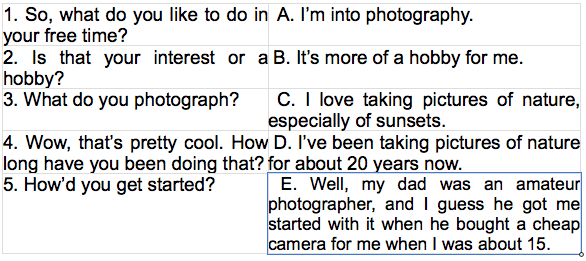In a previous blog, we began a short series on how to makes lessons with little to no prep time. That’s because sometimes, in this profession, we may not always have a lot of time to prepare.
It could be that we’re teaching consecutive lessons for hours at a time online. In addition, it could be that we’re asked to sub a class at the last minute.
Finally, it could be the case that we have a class assigned to us without notice.
There are several possible reasons why you might not have time to prepare a lesson. But today we’re going to show you how to navigate those rough waters.
And at the same time, how you can have happy adult students while keeping your confidence intact.
In this blog, we’ll be looking at what you can do with a blog. In addition, I’ll be using my own materials for a sample that can be found here: What Are Your Hobbies or Interests?
So, have a look at the material. After, let’s see what we can do with it in terms of creating a practical ESL lesson for adult learners.
Compare OnTESOL’s internationally accredited TESOL courses
What We Can Do With This?
Our goal is to turn this blog from simple reading material into an ESL lesson multivitamin. Thus, the points below will give you ideas about what you can do with this or any blog. Read on to learn more.
1. Pronunciation Building
If it’s a group class, you can have learners read the whole blog. Then, assign one reader per paragraph. If it’s a large group class, one reader per sentence can be fun too. If it’s a single private lesson, you can take turns with your student.
A few words that might be challenging from our example blog above might be:
figurines /fihg-gyr-reenz/
disengage /dihs-sihn-geidZ/
rewarding /ree-wahrd-deeng/
intriguing /ihn-treeg-geeng/
extinct /ehk-steengkt/
fascination /faes-sihn-neish-shn/
I’ve included sample pronunciation helps that you can use on a regular keyboard without technical symbols.
As readers encounter troubling words, you can now provide pronunciation assistance. Thusly, you’ve just incorporated pronunciation into your lesson.
2. Vocabulary Building
It’s possible, that if your student has difficulty pronouncing a word, she may not be familiar with its meaning.
It’s a rule of thumb that I’ve used over the years that’s proved more accurate than not. So, it’s a good place to start. Nevertheless, if you’re an experienced ESL teacher, you should have a good feel for what your learners know and don’t know.
From our example blog, you might notice the following words need to be defined:
- figurines (n.) small carved, molded, or shaped images
- de-stress (v.) to get rid of stress
- disengage (v.) to refocus your attention on something else
- cares of the world (n. phr.) the problems we face in life
- rewarding (adj.) giving personal satisfaction
- heavier issues (n. phr.) more serious problems in life safe to say (adj. phr.) to say something with surety or certainty, etc.
I’ve included sample definitions to help demonstrate how you can present the vocabulary. The grammar points can help learners understand better. If you can, try to avoid the dictionary definitions.
They may only serve to confuse. As much as possible, keep the meanings short, sweet, and relevant to the topic.
You can do this at the beginning, while reading, or after reading. It’s your call. But by doing it, you’ve taken the blog from just reading to a vocabulary builder.
You’ve just added a formal vocabulary element to your blog.
An extension activity would be to ask learners to create sentences related to the blog using the vocabulary.
Read: How to Introduce New Vocabulary
3. Pull Out at Least One Grammar Point
As you read through the blog, look for any singular basic grammar point that jumps out at you. From our example blog, we might point out …
Used to for Talking About Past Habits
I used to ____. / I didn’t use to ____.
Used to can be used with all types of verbs:
I used to collect Hot Wheels cars.
I didn’t used to spend a lot of time on my hobby when I was a kid.
As an extension, you can relate the grammar point to practical activity. For example, you can ask class members about themselves. In addition, you can ask them what activities they used to do when they were younger that they don’t do anymore.
In the end, whatever you decide to do with it, you now have a formal grammatical component for your blog lesson.
4. Comprehension Questions
While going over the blog, you may notice concepts that are worth checking. This helps you gauge whether learners are following and how to proceed from there. You can do this after each paragraph or after the blog as a whole.
From our example blog above, we might ask:

Using comprehension questions can help you determine how far you can go into the conversation.
They will also help you gauge the level of questions you might be able to ask. You can find more information about questioning techniques in a previous blog.
But, you’ve just added a comprehension element to this lesson. Little by little, we’re building a practical lesson.

5. Conversation Questions
Think about what you find interesting in the blog, and it’s possible your learners may feel the same. Using our example blog, we could create the following conversation questions:
1. Do you agree with the article that people don’t typically have hobbies anymore? Why/Why not?
2. In today’s age of information, do you think we suffer from too much information? Please explain.
3. Do you agree with the article that much of the news we receive is bad? Please explain.
4. Tell me what your interests are? How do you feed them (i.e. where do you find the source of information for your interests? How much time do you spend on your interests?)
5. Is there a hobby you’d like to start in the future or an interest that you want to know more about? Why?/Why not?
These are some questions that came to my mind about the subject. As you give it a once over before bringing it to class, let the questions come to mind while you read. Then, take note of them, and bring them with you.
Of course, you’ll need to have a clear mind, maybe a cup of coffee, and creativity, but you can do this. Having a conversation element helps round out your lesson.
Read: Reading Comprehension for Large ESL Classes
6. Put Together a Dialogue
We have a pretty good blog describing how you can put together dialogue from a news lesson on the fly. In addition, we also have other blogs sharing the use of dialogues. However, for our example, what could we do?
We can try something like this:
Two people talking about hobbies and interests.

Creating a dialogue on the fly may not be as difficult as you think. Yet, if you feel you don’t have enough time, try asking the class members to help you put a short one together. This is yet another activity to engage your learners.
Be sure to ask students to read the dialogue from both sides. For example, a possible follow-up activity after reading through the dialogue is providing real-life answers.
Learners can replace the information in the dialogue with their own answers. Then they can practice with their classmates or with you.

7. Ask Learners to Think of Questions to Ask
Another way to challenge learners with this reading material is to get them out of the answer mode.
By challenging them to put together questions for each other or for you, they learn more. They’ll learn the structure of questions.
They’ll develop improved conversation skills. Moreover, they’ll build more confidence. I like to give them something as simple as below:
Think of three questions you can ask your teacher or classmates about this topic and write them here:
1. ______________________________
2. ______________________________
3. ______________________________
Then I check the structure. Finally, when everything looks good, we have a time of questions from class members. It really can be fun. That’s because they can come up with some pretty interesting questions!
Read: Engaging Reading Activities For Your ESL Class
And Voila!
There you have it. You’ve just taken a blog (or any leisure reading material) and made a lesson out of it. And you’ve done it with little to no prep time.
Of course, in writing this, I’ve had time to prepare it. However, the ideas presented can guide you toward providing your learners with something more than just reading and talking. There’s much more we can do with reading material than that.
If you’d like to know more about lesson planning, contact us for more information. OnTESOL offers comprehensive TESOL training as well as specialist courses for previously certified teachers.
Recommended Reading:
Lesson Planning 101: How to Develop Meaningful ESL Lessons






